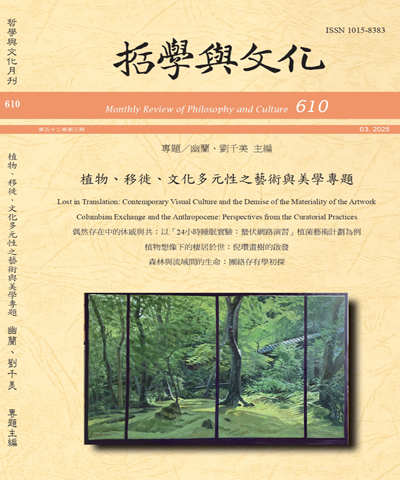
哲學與文化/Universitas: Monthly Review of Philosophy and Culture
哲學與文化月刊雜誌社,正常發行
選擇卷期
- 期刊
1.Being different from both the 'literal meaning' of the western metaphysics and in certain sense the 'real meaning' of 'Meta-physica', the inner meaning of Chinese metaphysics would be broader, that is to say, in addition to 'Meta-physica', there are 'Meta-ethica' and 'meta-phorica' in Chinese metaphysics. Of course, the 'supra-physic' of the metaphysics of 'Meta-physica' still takes 'conformity' as the criterion of judgment. And the 'supra-ethic' of 'Meta-ethica' and the 'supra-symbolic' of 'Meta-phorica' take 'experience' and 'understanding (Aletheia)' as the way to the truth. 2. The Greek philosopher Aristotle (384-322 B.C.) is the originator of the metaphysical approach of 'Meta-physica', and Thomas Aquinas (1224-1274), the great philosopher in the Middle Ages, takes it to the summit. From the modern time onwards, owing to the rapid development of physics, metaphysics, which is based on physics and at the same time 'transcends' physics, faces a rough time. The father of modem philosophy, Rene Descarte (1596-1650) makes metaphysics equal with physics. The confoundedness of metaphysics and physics, however, is not enough to curb the tendency of reason towards the realm of metaphysic. Then the German philosopher Immanuel Kant ( 1724-1804) attacks on the one hand the principle of causality and criticizes on the other hand Rationalism and Empiricism, which leads to many crises, especially sacrificing metaphysics to make basis for physics. Moreover, Empiricism and its later development, Analytical Philosophy, deny the possibility of metaphysics. Thus metaphysics encounters an enonnous catastrophe. Fortunately, the contemporary Neo-Scholastic Philosophy with its millennial tradition of 'Philosophy perennis' gradually surpasses the approach of 'Meta-physica' and tries to communicate with modern sciences in order to recover the glory of metaphysics. 3. The approach of ' Meta-physic a' examines the reality behind the sensible world by virtue of observing the sensible world, which is the same as the way of thinking in the Great Appendix of the I-King. Take a classic example, Fu Shi draws the eight trigrams by virtue of observing the world, which could see through the power of the divine and the imperceptible expressions of all things. However, Confucianism is always the mainstream of Chinese philosophy, of whose thought morality is the core. The Confucian metaphysics is therefore 'Meta-ethica', whose way of thinking is looking for the ultimate basis of morality through 'moral prescription. Starting with Confucius (551-479B.C.), besides proposing various virtues, and doing what is good and avoiding what is evil, Confucianism points out the philosophical question 'Why is morality' and meanwhile in certain respects gives explicit answers to it. The notion of 'Heaven' is the central idea. 4. In addition to the Confucianism, there is Taoism in the Chinese philosophy. Starting with Laotzu (ca. 571-467 B.C), Taoism is regarded as having profound metaphysical thought. The Taoist discussion of 'Tao' could be seen as a standard theme of 'ontology'. Whereas, Tao-fe-king affirms the 'Tao' as the' unnamed Tao' which can only be understood through 'metaphor', Therefore his metaphysical achievement has the character of' Meta-phoric'. Although 'Tao' can only be 'named as Tao' ,yet its metaphysically ontological character is still manifested. 5. Mencius (372-289 B.C.), on the one hand, changes Confucius' transcendental 'Heaven' into the inner existence by virtue of the theories of 'knowing Heaven through studying mind and nature' and 'knowing Heaven through cultivating mind and nature'. In the Sung and the Ming Dynasties, the Neo-Confucianists put all things in the human mind, which really arrives at the realm of 'the Ultimate Idealism'. Chuangtzu (ca. 369-286 B.C.), on the other hand, transforms Laotzu's transcendental 'Tao' into the inner existence through his theory of ‘Tao in excrement.' This thought of 'Tao is everywhere' has become the Taoist Pan-theism for two thousand years. 6. No matter whether 'being' is ontological transcendence or inner existence, and no matter whether it is ideal or pan-theistic, the ways of thinking of the Chinese metaphysics can still be seen from the three dimensions: 'Meta-physica', 'Meta-ethica', and 'Meta-phorica'.
- 期刊
在任何一個文化中,都少不了哲學,而在任何一種哲學中,形上學似乎永遠是引起熱烈探討的科目。因為哲學本身即是追根究底的一門學問,最為符合人性的需求,而在哲學的遼闊領域中,形上學探索的是根本問題中的終極本根或原理。在這篇省思中,只簡要地探討三個問題:壹、形上學是什麼?貳、形上學的核心理念--存有與虛無的問題。參、為什麼有許多人厭惡,排斥形上學?在西方哲學思想的發展史中,形上學和存有論有鼎盛時期,有衰落的時期,也有長期被抹黑並試圖置之於死地的時候。但是肯定形上學的學者也好,否定它的也好,皆不能自外於形上學而探討形上學。就如「有」即是「有」,總不能把有說成「無」或「沒有」。其理至明,如果在全球舉行世界公民投票,相信絕大多數的人會贊成:「有即是有」。為此可以說:「人」作為一個靈性動物,他的腳雖然站立在形而下的大地上,他的精神活動使他不能不承認自己的形而上的存在。
- 期刊
本論文分三大部份:第一部份討論中國的陰陽學說;筆者在這裡提出了易經的生命作為所有事物的原理。進一步,筆者同時亦指出:中國二大哲學流派,儒家和道家,皆淵源於易經:二者皆針對生命以及生生不息的功能,來詮釋宇宙和人生的原理。雖然老子與孔子所開創的道家和儒家,所走的思想進路有所不同,但基於對生命的尊重,以及對生命的目標相同,尤其對生命的來源,都有深沈的體驗,則二者對定位宇宙,以及在宇宙中安排人生,都有共識。 第二部份探討亞里士多德的形質說。筆者強調,亞氏所主張的因果原則,實可解決宇宙的現象和本質的課題。形質說特別針對形式因與質料因,二者的交互運作,使事物能從無到有,完成四因說中內在因的探討。在此因果原則的提案中,亞氏創設了「發展」(內在目的性)概念,指出所有事物都趨向目的。 第三部份作者提出一些比較,特別在通俗的、基督宗教文明的、中華文化中的「因果」問題。作者在這裡,再次提出「生」概念,原本在十八年前在美國華府名開的第十三屆「科學統一國際會議」中所提。在這裡,筆者提出更多的証據,不但從聖經中,或是教父學說中,都傾向於把「創造」解讀成「流出」。不過,作者無意於等同「創造」、「流出」、「生」三概念;而是強調,原本在「創造」的概念中,就隱含了「生」的意義。筆者具體提出聖多瑪斯和波拿文都辣的原文,作為佐証。 最後,筆者提出了一些見解,在解讀文鮮明牧師在這方面的理論。
- 期刊
拙文係從五個事例作起始,以探討「什麼是萬有的起源?」這一論題。這五個事例,分別是: 一、中國孔子對「天」的思想。 二、中國老子對「道」的構思。 三、古希臘哲人對「神明」的設定。 四、古希伯萊人對「耶威」(神)的認定。 五、現代科學大霹靂說對「造物主」的預設。 接而,即提出綜合整理;並且主張:萬有或宇宙的存在,確實是有它的起源。至於促使萬有有其起源的背後之動力,應當是:那具有生機(活力)、智慧、以及富涵多種德性的「終極實在(者)」。 我們世人(尤其前述五事例中的當事者),乃至有學者提出的學理(如:大霹靂理論),便是以類比、擬人化或位格性的認知角度,去詮解此一「終極實在」;結果,便有上述的「天」、「道」、「神明」與「造物主」...等稱號的出現。其實,依筆者之淺見,即從前述的論點──認定:「終極實在」,當是擁有生機(活力)、智慧...等特性──來看,他們應多在喻指同一位造物主,同一位(真)神,或同一位萬有的存在根基;可以用「眾存有者的基源」來形容祂(而非「它」)。因為,祂確實是眾生命的來源,也是諸無生命事物之被造生的本源。
- 期刊
本文嘗試從亞理斯多德的文本基礎出發,分析其形而上學之內在結構。亞理斯多德形而上學的概念與對象,長久以來一直是西方形而上學歷史演變過程中的一個重大課題,也由此環繞著諸種不同詮釋,形成各種文獻與思想的爭議。我們的分析工作之問題意識在於如何釐清第一哲學,存在作為存在之存有論,實體論與神學內在於亞理多德形而上學體系中的複雜關係。初步的結論是根據兩種不同涵義的「第一」與「普遍」的關聯,鋪陳出其「存有─神─邏輯」的結構。

